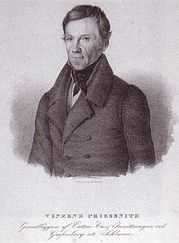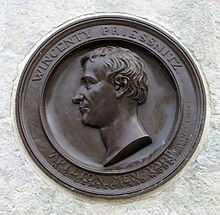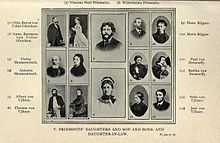Vincenz Priessnitz


Vincenz Priessnitz, also written Prießnitz (sometimes in German Vinzenz, in English Vincent, in Czech Vincenc; 4 October 1799 – 26 November 1851) was a peasant farmer in Gräfenberg, Austrian Silesia, who is generally considered the founder of modern hydrotherapy, which is used in alternative and orthodox medicine. Priessnitz stressed remedies such as suitable food, air, exercise, rest and water, over conventional medicine.[1][2][3] He is thus also credited with laying the foundations of what became known as Nature Cure,[4] although it has been noted that his main focus was on hydrotherapeutic techniques.[5] Priessnitz's name first became widely known in the English-speaking world through the publications and lecture tours of Captain R. T. Claridge in 1842 and 1843, after he had stayed at Grafenberg in 1841.[2][3] However, Priessnitz was already a household name on the European continent, where Richard Metcalfe, in his 1898 biography, stated: "there are hundreds of establishments where the water-cure is carried out on the principles laid down by Priessnitz".[6] Indeed, Priessnitz's fame became so widespread that his death was reported in the as far away as New Zealand.[7]
Biography
Young age
Vincenz Priessnitz was born into a farmer's family in the village of Gräfenberg (now Lázně Jeseník) near Frývaldov (now Jeseník) and baptized Vincenz Franz. His parents were among the first settlers of the village. When Vincenz was eight his father went blind and he had to help in the farm, especially after his elder brother died four years later. Once Vinzenz watched a roebuck with a wounded limb coming to a pond (or stream) to heal its wound.[8] He healed his own finger injured during timber felling with water wraps (1814). In 1816 he was injured more seriously when he broke his ribs in an accident with a cart and the doctor claimed it was fatal or at least crippling. He used his water therapy which took a year but eventually succeeded. He became locally renowned and started healing animals and some neighbours by pouring cold water. Soon queues of people were coming to Gräfenberg, so in 1822 Vincenz decided to rebuild his father's house, building part of it as a sanatorium for his patients.[1][9][10]
Success
In 1826 he was invited to Vienna to heal the Emperor´s brother Anton Victor, Grand Master of the Teutonic Knights.[9] It made him a great reputation so a lot of people from all over the country started to stream to Gräfenberg. Among the methods he used in his therapy there was not only cold water but also hard work and barefoot walks on grass. The diet and sleep regime were quite strict. His “sponge washing” was not accepted by local doctors of medicine, and so they complained and called him an impostor with no medical background. The complaints were denied by the imperial committee which accepted hydrotherapy as an alternative medical method and in 1838 granted Priessnitz a permit to establish the spa he started several years earlier.[1]
The next year 1500 patients arrived (among them one monarch, a duke and duchess, 22 princes and 149 counts and countesses[8]) and 120 doctors to study the new therapy.[9] A visit by Arch-Duke Franz Carl in October 1845 was greeted with an address extolling the virtues of Priessnitz and his methods, signed by 124 guests, from a variety of countries.[11][12] The new spa house, built that year with 30 rooms, was called Castle and the next house was called New Spa House.[13] In 1846 Priessnitz was awarded a medal by the Emperor.[13] Various aristocratic patients did him reverence by erecting monuments in the spa town. Among the most famous guests was Nikolai Gogol who visited the spa twice (1839 and 1846).[9]
Priessnitz's English biographer, Richard Metcalfe, notes that while despite the fame of the Graefenberg setting, the view of Priessnitz himself was that the therapeutic virtue was the water-cure treatment, not the locality.
- That Priessnitz was of this opinion appears from the fact that after his fame had spread throughout Europe, and people came to Graefenberg from all quarters, he did not confine his practice of hydropathy to that healthy region, but visited and treated patients at their own homes in towns, where similar success attended his manipulations.
- There are some who would stultify Priessnitz by making his saying, "Man muss Gebirge haben" (One must have mountains), to mean that he considered a mountainous region indispensable to the successful practice of hydropathy. But, as the facts stated above show, the whole career of Priessnitz gives the lie to such a notion.[14]
Vincenz Priessnitz died in 1851. Newspapers of the day reported that on the morning of his death "Priessnitz was up, and stirring about at an early hour and complaining of the cold, and had wood brought in to make a large fire. His friends had for some time believed him to be suffering from dropsy in the chest, and at their earnest entreaty he consented to take a little medicine, exclaiming all the while, 'it is no use.' He would see no physician, but remained to the last true to his profession".[7] At about four o'clock in the afternoon, "he asked to be carried to bed, and upon being laid down he expired.[7] Priessnitz's wife Sofie died in 1854, and was buried in the family crypt in Gräfenberg, where Priessnitz also lay. They had nine children,[15] comprising eight daughters and one son.[13] The son, Vincent Paul Priessnitz, was born on 22 June 1847, and died on 30 June 1884, aged 37.[13][16][a]

Legacy
The Museum of Vincenz Priessnitz is in the house which was the seat of the first hydrotherapy institute in Lázně Jeseník.
There is a statue of Priessnitz in Vienna (1911), in Kirchheim unter Teck[13] and a Priessnitz fountain by Carl Konrad Albert Wolff in Poznań, Poland[17]
The 200th anniversary of his birth was listed among the UNESCO anniversaries in 1999.[18]
A band from Jeseník named itself Priessnitz.
A Czech movie based on his life was made in 1999 under the name of Vincenz Priessnitz.[19]
Knowledge of Priessnitz's work in Britain led to the foundation of twenty hydropathic establishments. Of these, two remain one in Peebles, the other Crieff Hydro, Crieff.
In Literature
In The Confidence-Man by Herman Melville, the herb-doctor says, '"The water-cure? Oh, fatal delusion of the well-meaning Preisnitz!"
Further reading
- . (March 1857), "Life at the Original Water Cure", Putnam's Monthly Magazine of American Literature, Science and Art 9 (51): 244–255, retrieved 21 June 2010 Cornell University Library. Making of America collection.
- Selinger, J.E.M. (1852). "Vincenz Priessnitz. Eine Lebensbeschreibung." Mit portrait und facsimile. Wein: Verlag. Wien (Vienna): von Carl Gerold und Sohn..[16]
- Shew, Joel, M.D. The Water Cure Manual..
Notes
a. ^ Metcalfe's earlier essay on Priessnitz, while comprising a readily digestible summary of his life and work, is best reviewed in conjunction with other works, including Metcalfe's own later book on Priessnitz. For example, in Metcalfe's 1869 essay, he describes Priessnitz's eldest son as having died at an apparently young age.[15] However, there is no mention of this in Metcalfe's better researched 1898 book, which not only provides a picture of Priessnitz's adult son (per this article), but in which the son is stated as being born in 1847 and having died in 1884.[16] This is also consistent with the tribute website that gives the same birth and death dates, and which states the son's age at death as being 37.[13]
References
- ↑ 1.0 1.1 1.2 Metcalfe, Richard (1898). Life of Vincent Priessnitz, Founder of Hydropathy. London: Simpkin, Marshall, Hamilton, Kent & Co., Ltd. Retrieved 3 December 2009. Full text at Internet Archive (archive.org)
- ↑ 2.0 2.1 Claridge, Capt. R.T. (1842). Hydropathy; or The Cold Water Cure, as practiced by Vincent Priessnitz, at Grafenberg, Silesia, Austria. (3rd ed.). London: James Madden and Co. Retrieved 2009-10-29. Full text at Internet Archive (archive.org)
- ↑ 3.0 3.1 Claridge, Capt. R.T. (1843). Hydropathy; or The Cold Water Cure, as practiced by Vincent Priessnitz, at Grafenberg, Silesia, Austria. (8th ed.). London: James Madden and Co. Retrieved 2009-10-29. Full text at Internet Archive (archive.org)
- ↑ Benjamin, Harry (1946. First published 1938). Everybody's Guide to Nature Cure (8th ed.). London: Health For All Publishing. ISBN 978-1-4437-3551-3. Retrieved 2009-11-06. Check date values in:
|date=(help) - ↑ Szekely, Edmond (1951. First published 1938). Medicine Tomorrow: An Introduction to Cosmotherapy, with a Guide to Treatment. Ashingdon, Rochford, Essex, England: The C.W. Daniel Co. Check date values in:
|date=(help) Translated & Edited by Purcell Weaver. - ↑ Metcalfe, Richard (1898), p.v
- ↑ 7.0 7.1 7.2 "Death of Priessnitz", New Zealand Spectator and Cook's Strait Guardian (Papers Past), Vol. III (704), 1 May 1852: 3, retrieved 21 June 2010 (See last item at bottom of page).
- ↑ 8.0 8.1 "the central European spa tradition", Hidden Europe No.4, September 2005, retrieved 8 June 2010
- ↑ 9.0 9.1 9.2 9.3 Petr Slinták (20 July 2007). "Vincenz Priessnitz a jesenické prameny" [Vincenz Priessnitz and jesenicke Springs] (in Czech). ČRo Leonardo (Radio Leonardo). Retrieved 8 June 2010.
- ↑ Bradley, James (2003), Cold cure: Hydrotherapy had exotic origins, but became a firm favourite of the Victorian elite, Wellcome Trust: News and Features, retrieved 17 November 2009
- ↑ Metcalfe, Richard (1898), p.32
- ↑ Earl of Litchfield et al. (October 1845). "Translation of an address presented to Arch-Duke Franz Carl, on the occasion of his visit to Grafenberg". In Joel Shew (ed.). Water-cure journal. vol.1–2 1845–1846 Dec–Nov. New York: letter published in April 1846 volume. pp. 131–133. Retrieved 26 November 2009.
- ↑ 13.0 13.1 13.2 13.3 13.4 13.5 Němčík design (2003–2009). "Vincenz Priessnitz a lázně Gräfenberk" [Vincenz Priessnitz and spa Gräfenberk] (in Czech). Retrieved 8 June 2010. translate
- ↑ Metcalfe, Richard (1898), pp.158–159
- ↑ 15.0 15.1 Metcalfe, R (September 1869), "Vincent Priessnitz and His Water Cure", Herald of Health and Journal of Physical Culture, volumes 13–14 (New York: Wood & Holbrook) 14 (3): 121–126, retrieved 8 June 2010
- ↑ 16.0 16.1 16.2 Metcalfe, Richard (1898), p.vi
- ↑ Carl Konrad, "Albert Wolff", Art Encyclopedia (Answers.com), retrieved 9 June 2010
- ↑ Topí Pigula. "Aqua Vitae Vincenze Priessnitze" [Aqua Vitae Vincenz Priessnitz] (in Czech). Retrieved 9 June 2010.
- ↑ "Vincenz Priessnitz" (in Czech). Kino Světozor (Cinema Světozor). Retrieved 9 June 2010. Translate
|